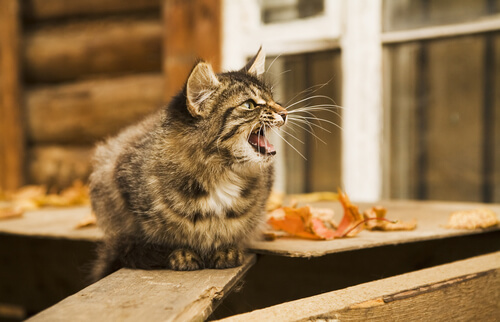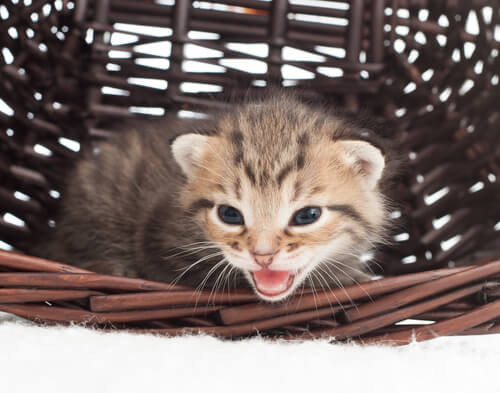Cat Meows and Their Meaning


Written and verified by the biologist Cesar Paul Gonzalez Gonzalez
Like other living beings, cats have developed their own “language” to communicate with each other and with other animals. This consists of a combination of body postures, scents, and vocalizations that become indirect messages to others. Among these, cat meows are perhaps the most obvious form of communication, although their meanings aren’t always obvious.
Cats use meowing to attract attention and to try to communicate with their owners. Although there are no rules to help translate feline vocalizations, some people have managed to decipher them and understand their pets’ requests. Continue reading this space and discover more about cat meows and their meanings!
How is the meow produced?
As in humans, cat meows are produced by the vocal cords found in the larynx. These cords are actually a type of tissue in the form of folds that vibrate with the passage of air, which causes the characteristic sound of the feline.
Contrary to what we may think, the vibration of the vocal cords is not random, but is controlled by various nerve impulses. In this way, the cat is able to modulate its meow and change the tone or magnitude of its vocalization. Therefore, it’s normal for each cat to have its own distinctive meow.

The meow is almost exclusive to cat-human interaction
The meow is actually a vocalization created by felines in order to communicate with their owners. In their daily lives, it’s rare for cats to communicate with their fellow cats by meowing. This is because messages are sent by other more efficient means, such as smells or body postures.
An exception to this rule are newborns, as it’s common for them to meow constantly to try to get their mother’s attention. However, as they grow older, they learn new ways to communicate and relegate vocalizations to their communication with humans.
In fact, this situation is best observed in feral cats, as they tend to develop fewer vocalizations than those of a domestic feline. Not growing up with the stimulus of tutors, the specimens restrict the diversity of their meows to the minimum necessary for their interaction with each other.
In addition, due to the long history of interaction with humans (domestication), felines have learned to generate conspicuous meows. This facilitates communication between cats and humans, as people tend to respond better to auditory stimuli.
Meows and their meanings
Experienced cat owners who have spent considerable time with their cats are usually able to interpret most of their vocalizations. However, there’s no certain method to know the different meanings of the meows.
Cats have great skill and control of their vocal cords, so it’s normal for their meow repertoire to be quite diverse. The changes in tonality, intonation, duration, and nuances, make each cat able to perform a precise vocalization for each situation of their daily life.
Moreover, a study by the Journal of Veterinary Science mentions that domestic felines are capable of producing at least 21 different vocalizations. However, it’s possible that this number is underestimated and that they may actually emit more than 60 sounds with different meanings.
This doesn’t mean that all cats emit the same meows, but that they are able to associate their vocalizations with more than 60 situations in their daily lives. Therefore, when spending a lot of time with the pet, owners learn to distinguish the distinctive tone of the meow for eating or playing. Some other situations in which felines tend to use the meow are as follows:
- To have the door opened for them
- To get attention
- Jealousy
- Aggression or warning
- Signal for help
- Greeting
- Discontent
- Discomfort
Cats become more talkative
Because meows are focused on interaction with owners, cats tend to become more talkative as people stimulate them. Viewed another way, as long as people talk to them and they receive positive reactions to their vocalizations, felines will become more likely to meow.
While it’s true that felines don’t understand words, they are able to interpret human body posture and associate everyday situations. As a result, they communicate effectively with their owners and understand their intentions. Of course, this doesn’t always mean that they always obey orders, as they may also choose to ignore them.

Although cat-human interaction hasn’t been studied as much as dog-human interaction, it’s just as interesting and complex. Of course, there’s still a long way to go to understand 100% of what your pet wants to say. However, we are gradually understanding more and more about the fascinating world of animal behavior.
Like other living beings, cats have developed their own “language” to communicate with each other and with other animals. This consists of a combination of body postures, scents, and vocalizations that become indirect messages to others. Among these, cat meows are perhaps the most obvious form of communication, although their meanings aren’t always obvious.
Cats use meowing to attract attention and to try to communicate with their owners. Although there are no rules to help translate feline vocalizations, some people have managed to decipher them and understand their pets’ requests. Continue reading this space and discover more about cat meows and their meanings!
How is the meow produced?
As in humans, cat meows are produced by the vocal cords found in the larynx. These cords are actually a type of tissue in the form of folds that vibrate with the passage of air, which causes the characteristic sound of the feline.
Contrary to what we may think, the vibration of the vocal cords is not random, but is controlled by various nerve impulses. In this way, the cat is able to modulate its meow and change the tone or magnitude of its vocalization. Therefore, it’s normal for each cat to have its own distinctive meow.

The meow is almost exclusive to cat-human interaction
The meow is actually a vocalization created by felines in order to communicate with their owners. In their daily lives, it’s rare for cats to communicate with their fellow cats by meowing. This is because messages are sent by other more efficient means, such as smells or body postures.
An exception to this rule are newborns, as it’s common for them to meow constantly to try to get their mother’s attention. However, as they grow older, they learn new ways to communicate and relegate vocalizations to their communication with humans.
In fact, this situation is best observed in feral cats, as they tend to develop fewer vocalizations than those of a domestic feline. Not growing up with the stimulus of tutors, the specimens restrict the diversity of their meows to the minimum necessary for their interaction with each other.
In addition, due to the long history of interaction with humans (domestication), felines have learned to generate conspicuous meows. This facilitates communication between cats and humans, as people tend to respond better to auditory stimuli.
Meows and their meanings
Experienced cat owners who have spent considerable time with their cats are usually able to interpret most of their vocalizations. However, there’s no certain method to know the different meanings of the meows.
Cats have great skill and control of their vocal cords, so it’s normal for their meow repertoire to be quite diverse. The changes in tonality, intonation, duration, and nuances, make each cat able to perform a precise vocalization for each situation of their daily life.
Moreover, a study by the Journal of Veterinary Science mentions that domestic felines are capable of producing at least 21 different vocalizations. However, it’s possible that this number is underestimated and that they may actually emit more than 60 sounds with different meanings.
This doesn’t mean that all cats emit the same meows, but that they are able to associate their vocalizations with more than 60 situations in their daily lives. Therefore, when spending a lot of time with the pet, owners learn to distinguish the distinctive tone of the meow for eating or playing. Some other situations in which felines tend to use the meow are as follows:
- To have the door opened for them
- To get attention
- Jealousy
- Aggression or warning
- Signal for help
- Greeting
- Discontent
- Discomfort
Cats become more talkative
Because meows are focused on interaction with owners, cats tend to become more talkative as people stimulate them. Viewed another way, as long as people talk to them and they receive positive reactions to their vocalizations, felines will become more likely to meow.
While it’s true that felines don’t understand words, they are able to interpret human body posture and associate everyday situations. As a result, they communicate effectively with their owners and understand their intentions. Of course, this doesn’t always mean that they always obey orders, as they may also choose to ignore them.

Although cat-human interaction hasn’t been studied as much as dog-human interaction, it’s just as interesting and complex. Of course, there’s still a long way to go to understand 100% of what your pet wants to say. However, we are gradually understanding more and more about the fascinating world of animal behavior.
All cited sources were thoroughly reviewed by our team to ensure their quality, reliability, currency, and validity. The bibliography of this article was considered reliable and of academic or scientific accuracy.
- Nicastro, N., & Owren, M. J. (2003). Classification of domestic cat (Felis catus) vocalizations by naive and experienced human listeners. Journal of Comparative Psychology, 117(1), 44.
- Prato-Previde, E., Cannas, S., Palestrini, C., Ingraffia, S., Battini, M., Ludovico, L. A., … & Mattiello, S. (2020). What’s in a meow? A study on human classification and interpretation of domestic cat vocalizations. Animals, 10(12), 2390.
- Ludovico, L. A., Ntalampiras, S., Presti, G., Cannas, S., Battini, M., & Mattiello, S. (2021, June). CatMeows: A publicly-available dataset of cat vocalizations. In International Conference on Multimedia Modeling (pp. 230-243). Springer, Cham.
- Tavernier, C., Ahmed, S., Houpt, K. A., & Yeon, S. C. (2020). Feline vocal communication. Journal of veterinary science, 21(1).
- Yeon, S. C., Kim, Y. K., Park, S. J., Lee, S. S., Lee, S. Y., Suh, E. H., … & Lee, H. J. (2011). Differences between vocalization evoked by social stimuli in feral cats and house cats. Behavioural processes, 87(2), 183-189.
This text is provided for informational purposes only and does not replace consultation with a professional. If in doubt, consult your specialist.








